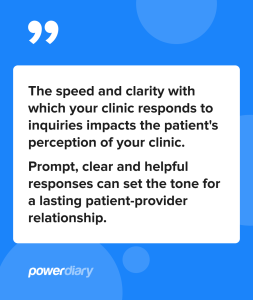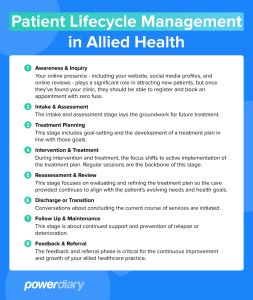In allied health, understanding patient lifecycle management is fundamental to providing high-quality care.
Why?
Because it promotes continuity, connection, early intervention, resource efficiency, communication, data-driven insights, and an improved patient experience – all of which ultimately lead to better health outcomes and patient satisfaction.
The patient lifecycle can be envisioned as a roadmap, charting the course of a patient’s journey with your healthcare practice (and beyond). It’s not just a series of appointments; it’s a holistic experience that includes initial engagement, diagnosis, treatment planning, ongoing care, and eventual discharge or conclusion of services.
Read on for our practical guide to understanding how each phase impacts patient care and clinic operations – and how to streamline processes with Power Diary.
Stage 1: Awareness & Inquiry
This stage sets the tone for the patient’s entire experience with your allied health practice.
Patients find your services in a variety of ways, ranging from professional referrals and personal recommendations to online searches and social media.
First impressions matter.
Your online presence – including your website, social media profiles and online reviews – plays a significant role in attracting new patients, but once they’ve found your clinic, they should be able to register and book an appointment with zero fuss. (And remember, you have split seconds to make an excellent first impression.)
Bear in mind…
The speed and clarity with which your clinic responds to inquiries impact the patient’s perception of your clinic. Prompt, clear and helpful responses can set the tone for a lasting patient-provider relationship.
Stage 2: Intake & Assessment
The intake and assessment stage lays the groundwork for future treatment.
Intake and Initial Consultation
This is a pivotal step where patients directly engage with your clinic and its services.
During the initial consultation, you’ll discuss the patient’s concerns, needs and personal health goals.
When you use the Power Diary online client portal for bookings, a notification is sent to the patient and the practice when a new patient registers. Notifications sent to patients can include helpful information and intake forms that automatically update information to the client profile, completely automating intake data entry.
Assessment
Assessment involves a comprehensive evaluation of the patient’s needs. Depending on your practice, this may involve physical examinations, detailed interviews, or questionnaires.
This stage is fundamental in building a solid therapeutic relationship and setting the course for effective treatment.
Using Power Diary session notes, you can record and store information gathered in this initial session so that it’s secure and readily accessible as treatment progresses.
Stage 3: Treatment Planning
The third stage in the patient lifecycle is where the path to wellness is strategically mapped out. It includes goal-setting and the development of a treatment plan in line with those goals.
This stage is streamlined by using the right practice management software.
Goal Setting
You and the patient work together to set achievable short and long-term goals. This collaboration is crucial for ensuring the treatment aligns with the patient’s expectations and lifestyle.
Treatment Plan Development
Treatment plans outline specific interventions, frequency of sessions, expected outcomes and dates for review.
Did you know that Power Diary clinical notes can easily be shared with patients via email so they have a copy of the agreed treatment plan?
Stage 4: Intervention & Treatment
During intervention and treatment, the focus shifts to active implementation of the treatment plan. Regular sessions are the backbone of this stage.
Depending on the nature of the plan, sessions could range from therapy and exercises to counselling or other interventions. The frequency and type of sessions are dictated by the individual treatment plan developed in the previous stage.
Incorporating practice management software into your practice can enhance your efficiency and effectiveness during treatment. Our recurring appointments feature is invaluable for scheduling regular sessions; it ensures consistency in treatment and makes it easier for you and the patient to track upcoming appointments.
The notes feature is another powerful tool – allowing you to document patient progress, and capture key observations, interventions used and patient responses. This ongoing documentation facilitates continuity of care.
Stage 5: Reassessment & Review
This stage focuses on evaluating and refining the treatment plan so the care provided continues to align with the patient’s evolving needs and health goals.
Periodic reviews are a vital component. Reviews are essential checkpoints that offer an opportunity to assess the effectiveness of interventions and the patient’s response.
In other words:
It’s an opportunity to update goals and modify interventions, ensuring treatment remains relevant and targeted.
Integrating practice management tools like Power Diary can streamline your administration. Power Diary session packs, for instance, are particularly useful for keeping track of the number of sessions provided and being notified when a progress report is due.
You can even use letter templates as a time-saving tool for creating progress reports. These templates streamline the process of documenting and communicating patient progress, both to the patient and other practitioners involved in their care.
Stage 6: Discharge or Transition
Conversations about concluding the current course of services are initiated. This decision is usually a collaborative one, involving careful consideration by both the practitioner and the patient. It’s based on thoroughly evaluating the patient’s health status and progress.
In some instances, the patient’s journey won’t end with discharge but rather a transition to a different form of care. This could involve shifting the patient to another service within the same clinic more aligned with their current needs or referring them to another practice.
Whether it’s a complete discharge or a transition to another form of care, Power Diary’s letter templates are a useful resource during this phase – facilitating the easy drafting and sharing of progress reports and referral letters.
When a patient’s status changes, update the status in your practice management system, archive profiles for discharged patients, and ensure that patient information is stored securely for the time period required by your local legislation before deletion.
Stage 7: Follow-Up & Maintenance
This stage is about continued support and prevention of relapse or deterioration.
Follow-up Sessions
For many patients, periodic follow-up sessions are beneficial to sustain their progress. These sessions provide opportunities to address new concerns and ensure patients remain on track with their health goals.
Maintenance Programs
Patients are often provided with home-based exercises, activities, or strategies tailored to their specific needs. These maintenance programs help patients continue their journey towards health and well-being independently.
Power Diary features can facilitate the management of follow-up and maintenance programs:
- Scheduling follow-ups: The client tasks feature in Power Diary can be used to schedule follow-up communications. This tool helps remind practitioners to invite patients to book follow-up appointments, ensuring consistent and timely engagement.
- Pre-set maintenance plans: Power Diary’s clinical note templates can be used to develop individual patient maintenance plans.
Stage 8: Feedback & Referral
The feedback and referral phase is critical for the continuous improvement and growth of your allied healthcare practice.
Encourage patients to provide feedback after their treatment. Constructive feedback is a key driver for quality enhancement in services, facilities and patient care.
Plus, when patients are satisfied with their experience, they become potential advocates for the clinic. Positive word-of-mouth and personal recommendations can positively impact your practice’s reputation and reach and result in referrals.
Incorporating Power Diary features can streamline this process as the software allows you to:
- Request feedback: The bulk send functionality in Power Diary can be used to request feedback from patients efficiently. It’s a simple way to engage patients who’ve completed treatment, providing them with an opportunity to share their overall experience.
- Integrate with Mailchimp: Our Mailchimp integration also allows clinics to send out communications requesting general feedback about the practice’s services and support.
The patient lifecycle in allied health requires careful attention at every stage. From initial awareness and inquiry to final feedback and referral, each phase plays a vital role in shaping the patient’s experience and outcomes.
Power Diary is designed to streamline your practice administration, offering features that support quality care. Sign up for a 14-day Free Trial of Power Diary today and discover how our powerful practice management software supports better patient management.







